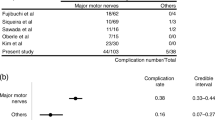Abstract
Purpose
The treatment of symptomatic Schwannoma is surgical excision. However, in the case of major peripheral nerves with motor function, there are concerns including neurological complications following surgery. This study was designed to evaluate the surgical outcome of Schwannomas originating from major peripheral nerves of the lower limb. Additionally, we sought to find out the predictable factors for permanent neurological deficits.
Methods
Between 2004 and 2008, 30 consecutive Schwannomas underwent simple excision or enucleation. Surgical outcomes after excision were evaluated with an emphasis on neurological deficits and recurrence. Neurological complications were classified as major or minor neurological deficits and evaluated immediately after surgery and at final follow-up. Risk factors for development of neurological deficits were identified.
Results
Twenty-three patients (23/30, 76.7 %) developed neurological deficits immediately after surgery. After a mean of 58.8 months (32–79 months), 19 patients (19/30, 63.3 %) showed no residual neurological deficits. Among the remaining 11 (11/30, 36.7 %), nine patients had tolerable symptoms and two patients had major neurological deficits including significant motor weakness and sensory impairments. Larger tumours tended to be at greater risk of neurological deficit after surgery. One recurrence of the tumour was seen two years after surgery. There were no cases of reoperation or malignant transformation
Conclusions
In the majority of cases, Schwannomas in the lower limb can be excised with acceptable risk for neurological deficits. However, meticulous dissection is required in large-sized Schwannomas because these tumours seem to have a higher frequency of fascicular injury during dissection.

Similar content being viewed by others
References
Knight DM, Birch R, Pringle J (2007) Benign solitary Schwannomas: a review of 234 cases. J Bone Joint Surg Br 89:382–387
Nawabi DH, Sinisi M (2007) Schwannoma of the posterior tibial nerve: the problem of delay in diagnosis. J Bone Joint Surg Br 89:814–816
Phalen GS (1976) Neurilemmomas of the forearm and hand. Clin Orthop Relat Res 114:219–222
Birch R, Bonney G, Wynn Parry CB (1998) The peripheral nervous system and neoplastic disease. In: Surgical disorders of the peripheral nerves. Churchill Livingstone, Edinburgh, pp 335–352
Ghaly RF (2001) A posterior tibial nerve neurilemoma unrecognized for 10 years: case report. Neurosurgery 48:668–672
Rockwell GM, Thoma A, Salama S (2003) Schwannoma of the hand and wrist. Plast Reconstr Surg 111:1227–1232
Donner TR, Voorhies RM, Kline DG (1994) Neural sheath tumors of major nerves. J Neurosurg 81:362–373
Oberle J, Kahamba J, Richter HP (1997) Peripheral nerve schwannomas–an analysis of 16 patients. Acta Neurochir (Wien) 139:949–953
Sawada T, Sano M, Ogihara H, Omura T, Miura K, Nagano A (2006) The relationship between pre-operative symptoms, operative findings and postoperative complications in Schwannomas. J Hand Surg Br 31:629–634
James MA (2007) Use of the Medical Research Council muscle strength grading system in the upper extremity. J Hand Surg Am 32:154–156
Park MJ, Seo KN, Kang HJ (2009) Neurological deficit after surgical enucleation of Schwannomas of the upper limb. J Bone Joint Surg Br 91:1482–1486
Kehoe NJ, Reid RP, Semple JC (1995) Solitary benign peripheral-nerve tumours. Review of 32 years’ experience. J Bone Joint Surg Br 77:497–500
Strickland JW, Steichen JB (1977) Nerve tumors of the hand and forearm. J Hand Surg Am 2:285–291
Artico M, Cervoni L, Wierzbicki V, D’Andrea V, Nucci F (1997) Benign neural sheath tumours of major nerves: characteristics in 119 surgical cases. Acta Neurochir (Wien) 139:1108–1116
Kang HJ, Shin SJ, Kang ES (2000) Schwannomas of the upper extremity. J Hand Surg Br 25:604–607
Lee SH, Jung HG, Park YC, Kim HS (2001) Results of neurilemoma treatment: a review of 78 cases. Orthopedics 24:977–980
Kim DH, Murovic JA, Tiel RL, Moes G, Kline DG (2005) A series of 397 peripheral neural sheath tumors: 30-year experience at Louisiana State University Health Sciences Center. J Neurosurg 102:246–255
Ozdemir O, Ozsoy MH, Kurt C, Coskunol E, Calli I (2005) Schwannomas of the hand and wrist: long-term results and review of the literature. J Orthop Surg (Hong Kong) 13:267–272
Yamane SMA, Kato H, Suenaga N, Iwasaki T (2002) Neurilemmoma in the brachial plexus [in Japanese]. J Jpn Soc Surg Hand 19:167–170
Takase K, Yamamoto K, Imakiire A (2004) Clinical pathology and therapeutic results of neurilemmoma in the upper extremity. J Orthop Surg (Hong Kong) 12:222–225
Kuo YL, Yao WJ, Chiu HY (2005) Role of sonography in the preoperative assessment of neurilemmoma. J Clin Ultrasound 33:87–89
Ogose A, Hotta T, Morita T, Otsuka H, Hirata Y (1998) Multiple Schwannomas in the peripheral nerves. J Bone Joint Surg Br 80:657–661
Conflict of interest
The authors declare that they have no conflict of interest.
Author information
Authors and Affiliations
Corresponding author
Rights and permissions
About this article
Cite this article
Kim, SM., Seo, SW., Lee, JY. et al. Surgical outcome of Schwannomas arising from major peripheral nerves in the lower limb. International Orthopaedics (SICOT) 36, 1721–1725 (2012). https://doi.org/10.1007/s00264-012-1560-3
Received:
Accepted:
Published:
Issue Date:
DOI: https://doi.org/10.1007/s00264-012-1560-3




